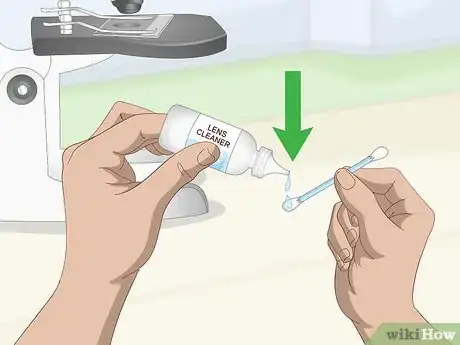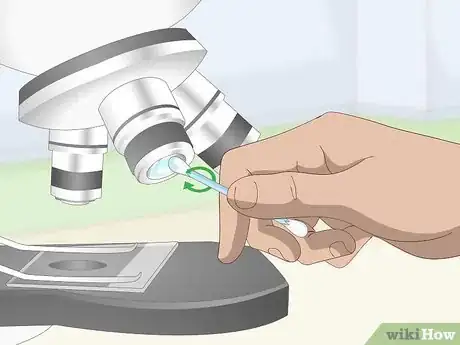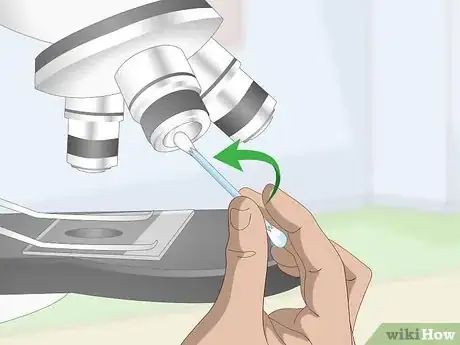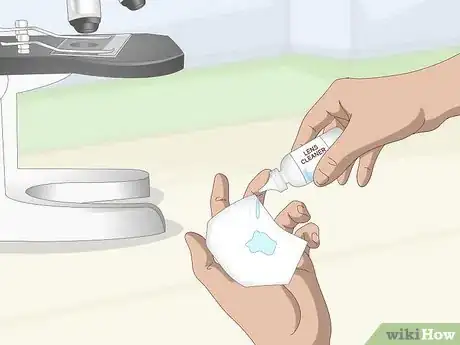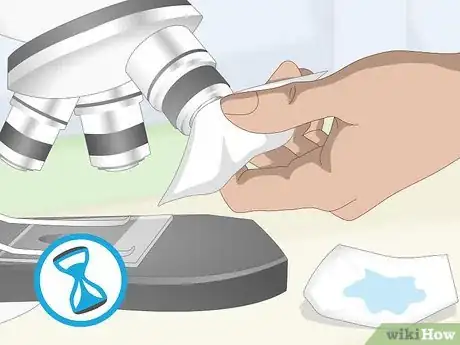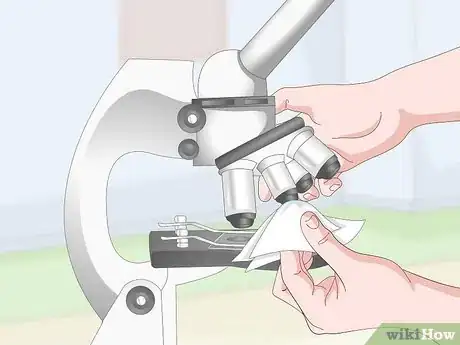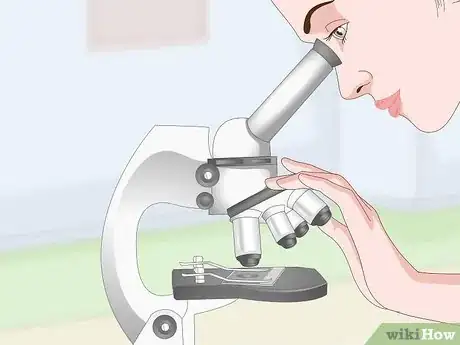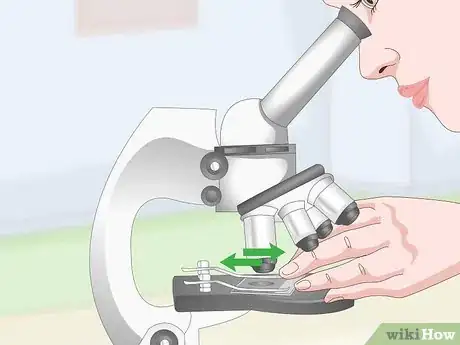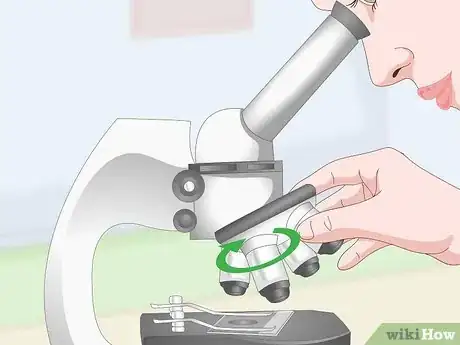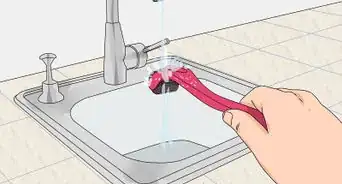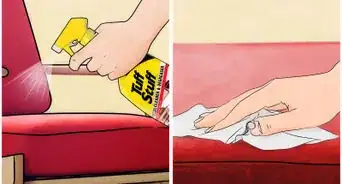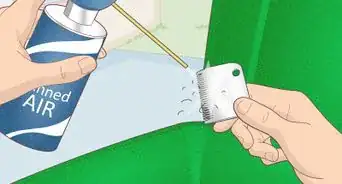This article was co-authored by wikiHow Staff. Our trained team of editors and researchers validate articles for accuracy and comprehensiveness. wikiHow's Content Management Team carefully monitors the work from our editorial staff to ensure that each article is backed by trusted research and meets our high quality standards.
There are 7 references cited in this article, which can be found at the bottom of the page.
This article has been viewed 33,759 times.
Learn more...
Dirt, dust, and oil can build up on microscope lenses over time, resulting in blurry, low-quality images. Fortunately, you can restore the image quality produced by the lenses by carefully cleaning them off. The right way to clean your microscope lenses depends on whether they're concave or convex. Either way, it's important that you work carefully and use the right tools so you don't damage the lenses. Once they're all clean, there are some things you can do to keep them in tip-top shape so your images always look clear and crisp.
Steps
Cleaning Concave Lenses
-
1Dampen a cotton swab with 1 to 2 drops of lens cleaning solution. A cotton swab will help you clean the surface of a concave lens, which curves inward. Be sure to use a lens cleaning solution, or a solvent like acetone or xylol.[1]
- If you’re using a solvent like acetone, take care not to get it on any plastic parts. Acetone dissolves most plastics and paints.[2]
-
2Rotate the damp swab gently in the center of the lens, moving outward. To cover the entire lens with your cleaning solution, move your swab in a spiral pattern from inward to outward. Once you’ve swabbed the outermost edge of the lens, you’ve covered the area.[3]Advertisement
-
3Dry the lens in a circular motion with the other end of the swab. To dry your lens, flip the cotton swab over to the dry end. Swab the lens in the same circular motion, moving inward to outward in a spiral pattern.[4]
Cleaning Convex Lenses
-
1Dampen a piece of lens paper with 1 to 2 drops of lens cleaning solution. Use lens paper specially made to clean lenses. Though lens paper is soft and specially made for sensitive surfaces like a microscope lens, it’s best to use it along with lens cleaning solution to prevent scratches.[5]
- Xylol can be used instead of solution for very stubborn or sticky residue.
-
2Hold the dampened lens paper against the lens for 5 to 10 seconds. Lenses of higher magnification, like a 10x lens, often use immersion oil to produce clearer images. This step will help break up any oil residue on your objective lens.[6]
- Lenses that use immersion oil should be cleaned with lens paper after each use.[7]
-
3Press a dry piece of lens paper against the lens for a few seconds. To soak up the lens cleaning solution from your lens, press a new piece of lens paper against the lens. Don’t use paper towels or other tissues to wipe your lens. This can scratch it or leave more dirt behind.[8]
Maintaining Your Lenses
-
1Wash your hands thoroughly before handling your microscope. To avoid transferring dust or debris to your microscope, wash your hands with soap and water. Dry them thoroughly, and put on gloves afterward.
- Gloves will prevent the natural oils in your skin from contaminating your microscope.
-
2Use a manual air blower to gently spray air onto the lens. A manual air blower, typically shaped like a bulb and made of rubber, can be squeezed to produce small blasts of air. Use a manual air blower to gently blow away any dust or debris.[9]
- You can purchase a manual air blower online or in electronics stores.
- You can also use a compressed air can, but be sure to use one that doesn’t contain any cleaning chemicals in it. This can damage the lens.[10]
- Be very careful not to touch the lens with the tip of the can or blower.
-
3Clean immersion oil from lenses with lens paper after each use. It’s important to clean off immersion oil after every use. Oil traps dirt, and can slowly dissolve glue in objective lenses. Press a piece of lens paper against the lens to soak up any oil.[11]
-
4Cover your microscope when not in use to protect it from dust. A microscope dust cover helps prevent dust from settling on your microscope. Tuck in the edges of the dust cover, or make sure it’s zipped or snapped shut. Store your microscope on a flat surface to prevent it from being knocked over.
Inspecting Your Microscope for Dirt
-
1Check the exterior of the eyepiece for residue. Since microscopes are sensitive and expensive pieces of equipment, you should avoid cleaning the lenses unless absolutely necessary. Look through the eyepiece using each objective lens. If you see residue using all lenses, your eyepiece is likely dirty.[12]
- If this is the case, spray your eyepiece with compressed air and wipe it gently with a lens paper.
-
2Move the slide back and forth while looking through the eyepiece. If the dirt moves along with it, the slide itself may be dirty. If the dirt stays in position, it may be your eyepiece or a lens.[13]
- If cleaning the exterior of your eyepiece doesn’t remove the dirt, it may be on the inside of the lens. It’s best to take it to a professional or contact the manufacturer to have it cleaned.[14]
-
3Look through the eyepiece with each lens to locate the dirty lens. If your eyepiece is clean, but you still see specks when using it, look through the eyepiece with each objective lens. If the dirt is only visible when using an objective lens, that’s the one that needs cleaning.
- For example, if you see dirt when using the 4x objective, but not the 10x or 400x objective lens, then your 4x objective lens is the dirty lens.
Warnings
- If you suspect the internal lens is dirty, have it inspected and cleaned by a professional service center. It’s best not to do this yourself since the image quality can be affected if it’s not done correctly.[15]⧼thumbs_response⧽
- Only use high-purity cotton cloths for cleaning lenses. Regular tissues or cloths can damage them.[16]⧼thumbs_response⧽
- Clean your microscope lenses when you notice dirt. Cleaning them too often increases the risk of damage to the lenses.[17]⧼thumbs_response⧽
- You can easily clean the lenses while they’re attached to your microscope. Try not to remove the lenses from the microscope while cleaning them, which can cause damage.[18]⧼thumbs_response⧽
Things You’ll Need
- Microscope
- Gloves
- Slide
- Air blower or compressed air
- Cotton swabs
- Lens paper
- Lens cleaning solution
- Microscope dust cover
References
- ↑ https://microscopy.duke.edu/guides/clean-objective
- ↑ https://microscopy.duke.edu/guides/clean-objective
- ↑ https://microscopy.duke.edu/guides/clean-objective
- ↑ https://youtu.be/LNE3Dgwdkl4?t=178
- ↑ https://youtu.be/LNE3Dgwdkl4?t=216
- ↑ https://youtu.be/LNE3Dgwdkl4?t=220
- ↑ https://microscopy.duke.edu/guides/clean-objective
- ↑ https://youtu.be/LNE3Dgwdkl4?t=237
- ↑ https://microscopy.duke.edu/sites/microscopy.duke.edu/files/file-attachments/The%20Clean%20Microscsope.pdf
- ↑ https://micro.magnet.fsu.edu/primer/anatomy/cleaning.html
- ↑ https://microscopy.duke.edu/guides/clean-objective
- ↑ https://microscopy.duke.edu/sites/microscopy.duke.edu/files/file-attachments/The%20Clean%20Microscsope.pdf
- ↑ https://microscopy.duke.edu/sites/microscopy.duke.edu/files/file-attachments/The%20Clean%20Microscsope.pdf
- ↑ https://micro.magnet.fsu.edu/primer/anatomy/cleaning.html
- ↑ https://micro.magnet.fsu.edu/primer/anatomy/cleaning.html
- ↑ https://microscopy.duke.edu/sites/microscopy.duke.edu/files/file-attachments/The%20Clean%20Microscsope.pdf
- ↑ https://microscopy.duke.edu/sites/microscopy.duke.edu/files/file-attachments/The%20Clean%20Microscsope.pdf
- ↑ https://micro.magnet.fsu.edu/primer/anatomy/cleaning.html
